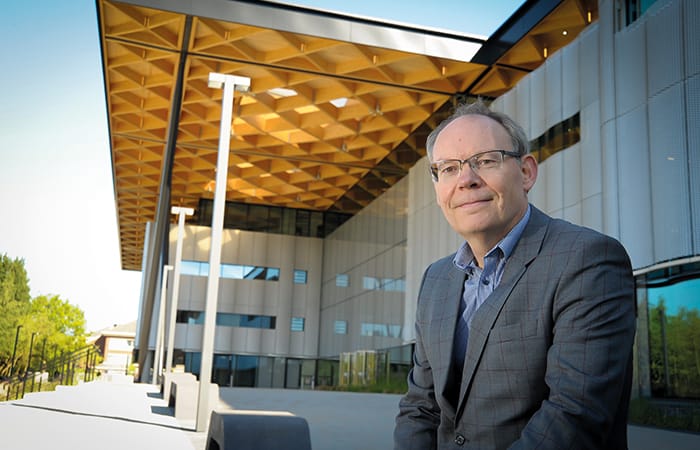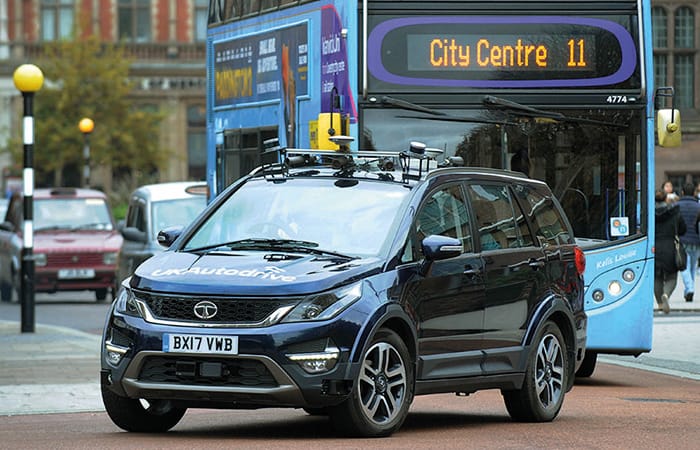Tata Motors’ top UK engineer Mark Sealy explains to Jon Excell how British expertise is driving innovation for the Indian car market
Fuelled by the spending power of its rapidly expanding middle class, the Indian automotive sector has changed beyond recognition in recent years to become one of the largest and fastest-growing markets on the planet.
And few firms have more direct experience of this transformation than the country’s biggest and best-known car maker, Tata Motors, which – in a short space of time – has evolved from a maker of robust workhorses for a cost-conscious Indian market to a globally ambitious manufacturer of modern, high-tech, and – many would say – desirable vehicles.

Pulling off this game of technological catch-up, particularly at a time when the rest of the global automotive sector has been evolving so rapidly, has owed much to the efforts of engineers here in the UK, at Tata’s Warwick University-based European Technical Centre (TMETC), a research division established in 2005 to enable the Indian manufacturer to tap into the region’s world-leading expertise.
Just before Christmas, The Engineer visited TMETC at its new base within Warwick University’s recently opened National Automotive Innovation Centre (NAIC) and heard from the group’s head of engineering and technology, Mark Sealy, about how the Indian market’s evolving appetites and expectations are driving the centre’s work.
Sealy, who joined Tata just under two years ago from IMI’s commercial vehicles division, explained that TMETC’s focus in recent years has shifted from “getting the basics right” to addressing many of the high-tech areas that dominate the rest of the car industry: from an insatiable demand for more efficient powertrains to electrification, connectivity, and even autonomy.
Much of the group’s work in these areas is, he said, driven by the Indian government’s fresh enthusiasm to ensure the country’s cars meet the latest regulations. “We’re right in the middle of trying to get to BS6 (the Euro 6 equivalent emissions level),” he said, “but unlike Europe where we went Euro 4, 5, 6 and spread out small cars, large cars, and heavy vehicles, India wants to go straight from 4 to 6 for every vehicle in the country simultaneously. It’s an almighty challenge for us as we have probably the broadest range of vehicles in India.”
A major area of focus therefore is chasing vehicle rapid efficiency gains in conventional powertrains and a key challenge here, said Sealy, is squaring efficiency improvements with India’s increasing appetite for SUVs. “All of these vehicle attributes go against efficiency because the vehicle becomes heavier and has worse aerodynamics, so we’re putting a lot of work in to allow that trend towards SUVs but with no penalty to vehicle efficiency.”
In the longer term, Sealy expects electrification to play a major role. And although the Indian government recently rowed back on its pledge to make 100 per cent of all new vehicles electric by 2030, a revised target of 30 per cent is still ambitious for a country with major infrastructure challenges and little domestic battery manufacturing expertise. Addressing these challenges is therefore a priority for TMETC, and electrification will be a major area of research at the group’s new home in the NAIC, said Sealy.
He added that this work is also helping drive Tata’s international ambitions, and confirmed that the firm is actively discussing bringing an electric version of its Nexon family SUV over to the UK.
An area that Sealy believes will have a more immediate impact on the Indian market is the rise of connectivity – a game-changing trend that uses communications technologies to enable vehicles to communicate with their users, other vehicles, and the roadside infrastructure.
“We think it will happen in India, possibly ahead of other countries simply because the Indian public are just so into their smartphones – the cost of mobile traffic is so low in India,” he said. Related to this is the concept of so-called “shared” pay-to-use models, where rather than owning a vehicle outright, mobile technology and apps are used to summon up vehicles when they’re required.
Whether it’s enabling inhabitants of remote villages to access vehicles that they’d otherwise be unable to afford, or offering a compelling alternative to the challenge of owning – and parking – a car in a congested city, Sealy believes it is a model that will be particularly compelling for the Indian market.

Much of the company’s expertise in these areas has been driven through its involvement in the UK Autodrive project – the UK’s biggest ever trial of driverless and connected vehicles – where it worked with Ford and Jaguar Land Rover (JLR).
The project, which concluded in late 2018, saw real-world demonstrations of technologies on the streets of Coventry and Milton Keynes, and as part of this, Tata used a modified Hexa SUV to test a range of features including GLOSA (Green Light Optimal Speed Advisory) and EEBL (Electronic Emergency Brake Light). It also demonstrated how vehicles and infrastructure will work in tandem for a motoring network in the future.
However, whilst these kinds of technologies have obvious potential for the Indian market, Sealy said that it is harder to see how Autodrive’s other area of focus – autonomy – could be easily applied to the chaos of India’s roads. “There’s a bit of doubt about its applicability to India because the driving is erratic, there’s unexpected traffic and events which would be very hard to predict for a machine.”
Although it could be argued, he agreed, that if you can crack autonomy in Delhi, you can crack it anywhere.
Beyond big global trends like electrification and driverless, Sealy explained that another important area of TMETC ’s remit is to look at technologies and projects that address particular domestic challenges. “It is a very hot climate, vehicles often have a high passenger count, so there are creature comfort-type innovations we’re working on,” he said.
“It is a very hot climate, so there are creature comfort-type innovations we’re working on”
“Air movement around the interior space is an issue, as is reducing the solar load. We’re also looking at road safety issues peculiar to the Indian market. If you take a German forward collision warning system and try to apply it in Mumbai or the suburbs of Delhi it doesn’t work.”
More generally, the pressure to innovate and to bring new technologies online for the Indian market is, he said, greater than it has ever been.
“When a new program starts we’ve got a list of innovations that are in the workshop and a target segment for that vehicle and we’re starting to say, ‘that therefore should be the platform’ that drags that idea through. In the past, a lot of these ideas have been thrown out to keep the cost down –but we can’t just carry on doing low cost.”
The move to the new innovation centre, which brings together 1,000 designers, engineers and researchers from Tata, WMG and Jaguar Land Rover, is – said Sealy – expected to supercharge this process by encouraging greater levels of collaboration.
Whilst Tata owns Jaguar Land Rover, Sealy explained that collaboration between the two firms has been limited in the past, partly because there was little overlap in the vehicles that they produced.
However, as Tata’s cars have become more sophisticated and JLR has become more cost-conscious this has begun to change, and the two companies have started to collaborate closely on key technology areas. “We’re working on a composites project together,” said Sealy, “and we’ve been working together in autonomy, digital, seat innovations, and tyre modelling. We have different problems but using the same tools.”
Despite a growing appetite to tap into each other’s experience, the two car makers have very different priorities however, something which is highlighted by their apparently differing attitudes to Brexit.
Whilst JLR has repeatedly – and with good reason given its dependence on pan-European supply chains – sounded some of UK industry’s loudest warnings, Tata itself appears less concerned, said Sealy. “Tata is – I think – not that bothered about Brexit and in some respects it may help to drive a better unilateral relationship between the UK and India.
They have a fairly un-European perspective. I’m not surprised JLR is wading in to say it needs some kind of certainty. It would have a very big impact on JLR’s ability to access supply chains in Europe and sell vehicles in Europe, but we are outside of all that.”




Swiss geoengineering start-up targets methane removal
No mention whatsoever about the effect of increased methane levels/iron chloride in the ocean on the pH and chemical properties of the ocean - are we...